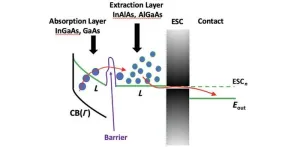(Press-News.org) KANEOHE, HI (Sept 24, 2024 1:05 p.m. HST)- In a study published today in Proceedings of the Royal Society B, researchers at the UH Hawaiʻi Institute of Marine Biology (HIMB) Toonen- Bowen “ToBo” Lab have identified scenarios under which eight of the most common species of coral found in Hawaiʻi can adapt to and survive ocean warming and acidification. The corals in the study are prevalent throughout the Indo-Pacific, a region that comprises more than two-thirds of the coral reefs on planet Earth, and were found to be capable of surviving a “low climate change scenario,” where laboratory conditions reflect a global reduction in carbon dioxide emissions. Critically, none of the species in the study could withstand a “business-as-usual” carbon dioxide emissions scenario. This finding suggests that curtailing carbon dioxide emissions is essential for the survival of coral reefs.
“This study shows that widespread and diverse coral species all exhibit the potential to adapt to the changing climate, but climate change mitigation is essential for them to have a chance at adaptation,” explains HIMB post-doctoral researcher and lead author of the study, Christopher Jury. “None of the coral species are likely to keep up with a high rate of climate change, but all eight can likely keep up with a low rate of change as targeted under the Paris Climate Agreement.”
Massive reef structures are formed over time through a process known as “coral calcification,” where individual coral organisms—or polyps—craft their own skeletons by secreting a salt known as calcium carbonate which becomes limestone. Growth is gradual; some coral colonies grow less than an inch each year, and researchers use coral growth rate as an indicator of reef ecosystem health. For nearly one year, the ToBo lab research team used biologically diverse, semi-enclosed outdoor “mesocosms,” to simulate realistic field conditions. They controlled levels of temperature and acidity, and measured the calcification responses of the eight species of coral.
"When we analyzed how the corals performed under warmer, more acidic conditions, we found that about one quarter to one half of their tolerance is inherited through their genes,” explains Rob Toonen, professor at HIMB and principal investigator of the project. “That means the ability to survive under future ocean conditions can be passed along to future generations, allowing corals to adapt to ocean warming and acidification."
Global climate change is rapidly altering the conditions coral reefs have adapted to over millennia, and most projections for the future of coral reefs have thus far been grim. These results are highly unexpected, and welcome.
“This was a very surprising result, given the usual projected collapse of coral reefs in Hawai‘i and globally under these climate change stressors,” emphasizes Jury. “Most projections are that corals will be almost entirely wiped out, and coral reefs will collapse within the next few decades because corals cannot adapt fast enough to make a meaningful difference. This study shows that is not true, and we still have an opportunity to preserve coral reefs.”
Over half a billion people depend on coral reefs for food, income, and protection, and reefs are among the most biologically diverse ecosystems on Earth. They protect coastlines from storms and erosion, provide jobs for local communities, and are a source of food, medicine, and recreation. The ability for corals to adapt to combined warming and acidification will play a key role in their responses to global change over coming decades. Most studies examining their ability to adapt have focused on heat tolerance. Far less is known about corals’ capacity to adapt to more acidic conditions, and very few studies have examined their capacity to adapt to the combination of warming and acidification. Mounting evidence indicates that many coral species harbor greater capacity to adapt to the changing climate than is often appreciated.
“We included the eight most common coral species in Hawai‘i, which constitute about 95% of the coral cover on Hawaiian reefs,” shares Jury. “By understanding how these species respond to climate change, we have a better understanding of how Hawaiian reefs will change over time and how to better allocate resources as well as plan for the future.”
Funding for this study was provided by the National Science Foundation, University of Hawaiʻi Sea Grant College Program, and the National Oceanic and Atmospheric Administration’s Ocean Acidification Program.
END
With curtailed carbon emissions, corals can survive climate change
2024-09-25
ELSE PRESS RELEASES FROM THIS DATE:
Global prevalence of short-sightedness in children and teens set to top 740 million cases by 2050
2024-09-24
Around 1 in 3 children and teens around the world is short (near)-sighted, with the global prevalence of myopia set to top 740 million cases by 2050 in this age group, finds a pooled data analysis of the available evidence, published online in the British Journal of Ophthalmology.
Female sex, East Asian or urban area residence, and educational level all seem to be key factors influencing prevalence, the findings indicate.
Short (near)-sightedness (myopia), which describes difficulty seeing objects at a distance, typically starts in early childhood and tends to worsen with age, explain the researchers. It has emerged ...
Urgent rethink of bottled water’s huge and growing toll on human and planetary health
2024-09-24
The huge and growing toll bottled water is taking on human and planetary health warrants an urgent rethink of its use as 1 million bottles are bought every minute around the globe, with that figure set to rise further still amid escalating demand, warn population health experts in a commentary published in the open access journal BMJ Global Health.
Some 2 billion people around the world with limited or no access to safe drinking water rely on bottled water. But for the rest of us, it’s largely a matter of convenience and the unshaken belief—aided and abetted by industry marketing—that bottled water is safer and often healthier than tap ...
Women still missing out on treatment for their No 1 killer—cardiovascular disease
2024-09-24
Women in the UK, and elsewhere, are still missing out on vital treatment for their No 1 killer—cardiovascular disease—despite significant progress in the medical management of heart disease and stroke, concludes a consensus statement published online in the journal Heart.
They continue to be underdiagnosed, undertreated, and underrepresented in clinical trials in all areas of cardiovascular disease, says the statement. Among other things, it calls for dedicated women’s heart champions and heart hubs, plus a women’s ...
Palestinian education ‘under attack’, leaving a generation close to losing hope, study warns
2024-09-24
The ongoing war in Gaza will set children and young people’s education back by up to five years and risks creating a lost generation of permanently traumatised Palestinian youth, a new study warns.
The report, by a team of academics working in partnership with the United Nations Relief and Works Agency for Palestinian Refugees in the Near East (UNRWA), is the first to comprehensively quantify the war’s toll on learning since it began in October 2023. It also details the devastating impact on children, young people and teachers, supported by new accounts from frontline staff and ...
Semaglutide improves outcomes for obese patients with common skin condition, new study shows
2024-09-24
(Wednesday, 25 September 2024, Amsterdam, Netherlands) A pioneering study, presented today at the European Academy of Dermatology and Venereology (EADV) Congress 2024, demonstrates the significant potential of semaglutide in treating hidradenitis suppurative (HS), a common and chronic skin condition, in people with obesity.1
This is the first study to explore the use of semaglutide for HS, marking a critical milestone in the search for effective treatments for this painful and debilitating condition.
HS is currently estimated to affect approximately 1 in 100 people, with obesity being a significant risk factor. The condition is characterised ...
Could GLP1RA drugs lower high iron levels?
2024-09-24
GLP1RA agonists have been increasing in popularity for treating obesity and type 2 diabetes.
With this novel treatment proving to be very effective, researchers are curious to know more about what other potential treatments it could also hold.
Researchers at the University of Michigan investigated another potential way GLP1RA drugs can be useful in treating type two diabetes associated with a genetic condition that causes high levels of iron, called hereditary hemochromatosis.
High iron levels with hereditary hemochromatosis can cause predisposition to liver disease ...
C-Path’s PKD outcomes consortium receives BAA Award for project to advance drug development tools for autosomal dominant tubulointerstitial kidney disease
2024-09-24
TUCSON, Ariz., Sept. 19, 2024 — Critical Path Institute (C-Path) is thrilled to announce its Polycystic Kidney Disease Outcomes Consortium (PKDOC) has been awarded an Autosomal Dominant Tubulointerstitial Kidney Disease (ADTKD) focused Broad Agency Announcement (BAA) contract from the U.S. Food and Drug Administration (FDA). The overarching objective of the work supported by the BAA award is to leverage collaboration with the Wake Forest Rare Inherited Kidney Disease team and its ADTKD registry, to analyze clinical and laboratory data that will help evaluate prognosis in ADTKD and help set the stage for future clinical trials.
ADTKD only affects ...
New insights into hot carrier solar cells: Increasing generation and extraction
2024-09-24
Hot carrier solar cells, a concept introduced several decades ago, have long been seen as a potential breakthrough in solar energy technology. These cells could surpass the Shockley–Queisser efficiency limit, which is a theoretical maximum efficiency for single-junction solar cells. Despite their promise, practical implementation has faced significant challenges, particularly in managing the rapid extraction of hot electrons across material interfaces.
Recent research has focused on using satellite valleys in the conduction band to temporarily store hot electrons before collection. However, ...
Clinical trial results show low-intensity therapy can achieve positive outcomes for certain pediatric leukemia subtypes
2024-09-24
(MEMPHIS, Tenn. – Sept. 24, 2024) – Clinical trial results from St. Jude Children’s Research Hospital demonstrate benefits to using genomics and early treatment response to guide risk classification of children with B-cell acute lymphoblastic leukemia (B-ALL). Traditionally, the intensity of a patient’s chemotherapy regime is guided by the National Cancer Institute (NCI) risk classification, which is largely determined by clinical characteristics such as age and white blood cell count at presentation. Through the flagship St. Jude ...
How emotion boosts memory for context
2024-09-24
Researchers at the Beckman Institute for Advanced Science and Technology demonstrated that emotion enhances memory for contextual details, challenging the view that emotion impairs the ability to remember such information.
The report was led by doctoral student Paul Bogdan, currently a postdoc at Duke University, and Florin and Sanda Dolcos, professors of psychology and neuroscience at the University of Illinois Urbana-Champaign.
Their research appears in the Journal of Experimental Psychology: ...





